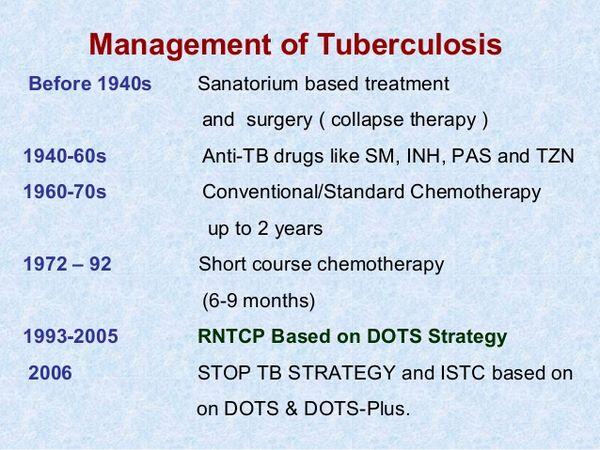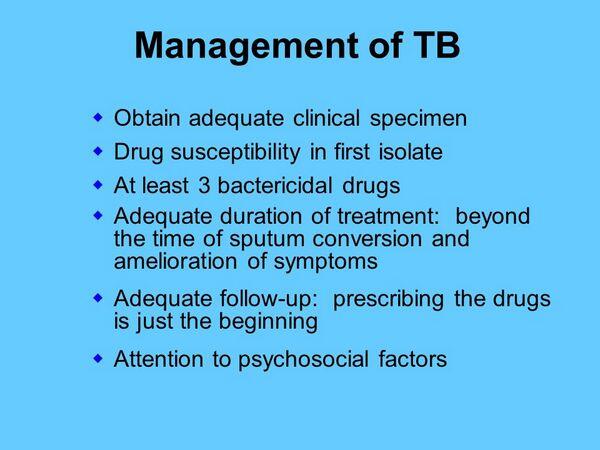Tuberculosis was a disappearing disease in North America until the early 1980s. However, the spread of human immunodeficiency virus infection has changed that. From 1985 to 1992 there was an increase in the number of cases of tuberculosis reported in the United States, and most of these cases were in New York, New Jersey, Texas, Florida, and California.

The other major change in the epidemiology of tuberculosis has been the emergence of multidrug-resistant disease. Factors contributing to this problem in the United States include inadequate public health resources to meet increased needs and unstable living conditions for many of the patients (especially in the homeless injection drug users, many with coexistent human immunodeficiency virus infection). In this setting of altered immunity, mycobacterial loads are high, resulting in increased rates of spontaneous random mutations leading to drug resistance.
Poor compliance with therapy or decreased absorption of antituberculous agents in human immunodeficiency virus patients with gastrointestinal disease are additional factors leading to multidrug-resistant tuberculosis. Multidrug-resistant TB (MDR-TB) refers to resistance to at least INE and rifampin.
Clinical manifestations
Since M. tuberculosis grows slowly, pulmonary TB frequently develops insidiously. Low-grade fever, night sweats, malaise and weight loss are classic systemic symptoms. Cough, often with mild hemoptysis and pleuritic chest pain, are the usual pulmonary symptoms. There may be no abnormalities on chest examination, but crackles and a pleural friction rub over involved areas can often be heard on auscultation (listen over apices!).
There are two forms of tuberculosis — primary and secondary (reactivation). Primary TB is usually a disease of infants and children. However, in countries where large numbers of adults have not been infected with TB, primary infection is also seen in the adult population. Hilar or paratracheal lymph node enlargement with or without a parenchymal infiltrate is a characteristic finding in primary TB. Reactivation TB is the most commonly seen form of the disease. Under certain circumstances (immunosuppression, increasing age, malnutrition) dormant and immunologically contained bacteria from the primary infection can begin to multiply and cause disease. Here the lesions are in the apical or posterior segments of the upper lobes or superior segment of the lower lobe.
Tuberculosis is transmitted by airborne spread from person to person via infected respiratory secretions. Those with laryngeal TB or with pulmonary cavitation are most infectious.

Diagnosis of tuberculosis
The gold standard is isolation of M. tuberculosis from sputum or other specimens. A positive acid-fast stain of a sputum specimen in the appropriate clinical setting can lead to a rapid diagnosis of TB. It is important to remember that a positive acid-fast smear is not specific for M. tuberculosis and that a variety of mycobacteria, both pathogenic and nonpathogenic species, and Nocardia spp. are also acid-fast. The tuberculin skin test can be used to identify persons infected with M. tuberculosis.
Tuberculin skin (Mantoux) testing has three principal indications — diagnosis of infection, diagnosis of disease, and as an epidemiological tool (Canadian TB Standards 1996). It should not be performed on persons with severe blistering tuberculin reactions in the past; patients with documented active TB; patients with extensive burns or eczema; or patients with infections or vaccinations with live virus vaccines (e.g., mumps or measles) in the past month (Canadian TB Standards 1996). False-negative tests occur, especially in the seriously ill who are often anergic. It is noteworthy that only 37% of patients recognize a positive test, so do not rely on patients’ recall of the test result. Test results may vary by 15% between arms and by 15% between different observers. The Mantoux test is read at 48 to 72 hours following intradermal inoculation, by measuring the widest diameter of induration (not erythema).
A positive test varies with the clinical setting. Less than 5 mm induration is a negative reaction indicating no infection with M. tuberculosis. If there has been recent exposure to TB and the test is negative it should be repeated in 12 weeks. Induration of ≥5 mm is considered positive, in human immunodeficiency virus-positive patients, in recent contacts of known TB cases, and in those with an abnormal chest radiograph compatible with TB. Induration of ≥10 mm is positive in persons who do not meet the above criteria but who belong to one of the following groups:
- Injection drug users known to be human immunodeficiency virus seronegative
- Persons with conditions that have been reported to increase the risk for progressing from latent TB to active TB, including diabetes mellitus, conditions requiring corticosteroids or other immunosuppressive therapy, some hematological malignancies, silicosis, gastrectomy, jejunoileal bypass, ≥10% below ideal body weight
- Residents and employees of prisons, jails, nursing homes, health care facilities
- Immigrants (within 5 years) from countries having a high prevalence of TB
Induration of ≥15 mm is positive in persons who do not meet any of the above criteria.
Among children vaccinated with bacille Calmette-Guérin (BCG) in infancy, 7.9% had a significant reaction 10 to 25 years later compared with 18% for those vaccinated between 1 and 5 years of age, and 25.4% for those vaccinated after 5 years of age. Thus, in general, a positive Mantoux >10 years after BCG vaccination should not be attributed to the vaccine. Reactivity to tuberculin antigen can diminish to nonreactivity with age. However, repeat TB skin testing may boost this reactivity. Thus, it is important in certain populations (e.g., nursing home residents, health care workers) who are going to have serial testing, to determine those whose response has waned over time. This is done by using the two-step test. A second test dose is administered 2 to 3 weeks after the first. The following groups of individuals should receive a Mantoux test.
- Those with signs or symptoms of tuberculosis, or a history of previous TB
- Recent contacts of known TB cases
- Those with abnormal chest radiograph compatible with TB
- human immunodeficiency virus-infected persons
- Those with medical conditions that increase the risk of TB (silicosis, gastrectomy, diabetes, immunosuppressive therapy, lymphomas)
- Groups at high risk of recent infection with M. tuberculosis (personnel and residents of nursing homes, prisons, some hospitals, immigrants from Asia, Latin America, Africa, Oceania)
A positive Mantoux test should prompt a chest radiograph. If this is negative, preventative therapy with Isoniazid (INH) should be considered. The reason for this is that among immunocompetent hosts, TB infection acquired in childhood progresses to active disease at some time during life in 10% of those infected. Of Mantoux-positive human immunodeficiency virus-infected drug users, 7 to 10% per year developed TB.
For prevention of the development of clinical disease in Mantoux-positive patients, INH 5 to 10 mg per kg, not to exceed 300 mg per day, is given for 6 to 9 months in adults, or 9 months in children. Human immunodeficiency virus-positive persons should receive INH for 12 months. When considering preventive therapy, the risk of hepatotoxicity due to INH must be considered. Because this toxicity is age-related, INH preventative therapy is not routinely offered to those who are older than 35 years (American Thoracic Society 1994). A full course of INH therapy is effective, resulting in reduction in rates of tuberculosis as high as 70%. For those who are Mantoux-positive following exposure to a patient with INH-resistant TB, use rifampin 600 mg/day as preventative therapy. For those exposed to INH- and rifampin-resistant TB and who are Mantoux-positive, no effective preventive therapy regimens have been established. Combination therapy with two drugs to which the organism is likely to be susceptible is recommended. Such combinations include pyrazinamide and ethambutol; pyrazinamide and a quinolone; or ethambutol and a quinolone.
Treatment of active tuberculosis
Treatment of active infection due to tuberculosis has two aims: to cure the infection in the patient, and to prevent spread to others.
Prevention of spread
Health care facilities should have appropriately ventilated isolation rooms and written policies for preventing transmission of TB. All persons with known or suspected TB should be hospitalized in an isolation room and placed on respiratory (airborne) precautions. Isolation may be discontinued when three consecutive sputum smears are negative for AFB on 3 different days, and after the patient has received effective therapy and is improving clinically (CDC 1994). This usually takes 2 to 3 weeks. If the patient is infected with resistant M. tuberculosis, isolation should be maintained throughout hospitalization because of the tendency for treatment failure (Dooley et al. 1990; CDC 1994). Personnel respirators (surgical masks are not adequate) should be provided by health care facilities and worn by persons in the same room with a patient with known or suspected TB. These devices should also be worn when performing procedures (such as bronchoscopy) that are likely to produce bursts of droplets. Wearers should be trained in the use and disposal of personal respirators. The health department should be notified of all cases of TB so that contact tracing can be carried out.
Drug treatment of active tuberculosis
The treatment of multidrug-resistant TB is so difficult that such patients should be managed by those with expertise in this field. If there is any doubt about compliance with therapy, implement twice weekly directly observed therapy. In one study only 77% of patients completed a recommended course of therapy within 12 months. This is one of the reasons for the rise in MDR-TB. Directly observed therapy is bringing rising rates of TB under control.
Vaccination against tuberculosis?
In the United States, BCG vaccination is recommended for: tuberculin-negative infants and children who have continuing exposure to INH- and rifampin-resistant active TB; those who cannot take INH and have ongoing exposure to a case of infectious TB; or those who belong to groups with rates of new M. tuberculosis exceeding 1% per year. However, the emergence of multidrug-resistant TB and institutional outbreaks of this infection have led to consideration of broadened use of BCG vaccine in the United States (CDC 1991). In a meta-analysis of the efficacy of BCG vaccine, Coldiz and coworkers (1994) reviewed 70 articles and included 14 prospective trials and 12 case-control studies in the analysis. They concluded that BCG vaccination reduced the risk of TB by 50%. Age at vaccination did not enhance protectiveness of BCG. Protection against tuberculous death, meningitis, and disseminated TB cases is higher than the protection rate for total TB cases. They concluded, however, that misclassification of disease may have led to the last-mentioned finding.
| Table Regimen Options for the Initial Treatment of Tuberculosis among Children and Adults | |||||||||||||||||||||||||||||||||||||||||||||||||||||||||||||||||||||||||||||||||||||||||||
|
|||||||||||||||||||||||||||||||||||||||||||||||||||||||||||||||||||||||||||||||||||||||||||
| Table Dosage Recommended for the Initial Treatment of Tuberculosis among Childrena and Adults | |||||||||||||||||||||||||||||||||||||||||||||||||||||||||||||||||||||||||||||||||||||||||||
|
|||||||||||||||||||||||||||||||||||||||||||||||||||||||||||||||||||||||||||||||||||||||||||
| Table Second-Line Antituberculosis Drugs | ||||||||||||||||||||||||||||||||||||||||||
|
||||||||||||||||||||||||||||||||||||||||||




